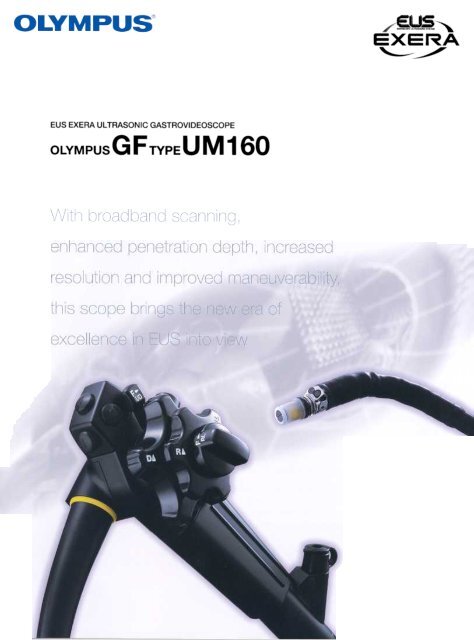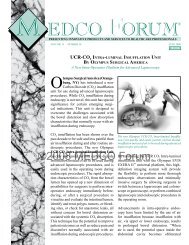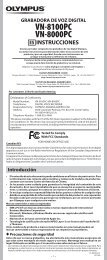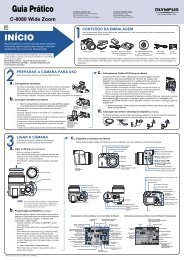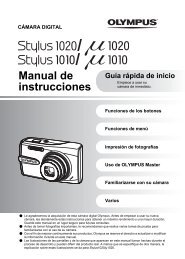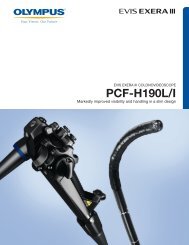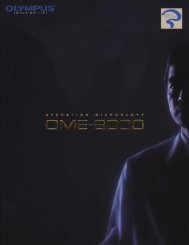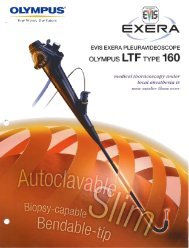Sales Brochure: GF-UM160 - Olympus America
Sales Brochure: GF-UM160 - Olympus America
Sales Brochure: GF-UM160 - Olympus America
Create successful ePaper yourself
Turn your PDF publications into a flip-book with our unique Google optimized e-Paper software.
EUS EXERA ULTRASONIC GASTROVIDEOSCOPE<br />
OL YM PUS G F TYPE U M 160<br />
~UA~<br />
EXERA<br />
" :-_~.../'
EUS Incorporating<br />
From The Layer Structure To Deeper Organs,<br />
The All-New HyperBand Transducer Makes Possible Ultrasound Imaging<br />
Over A Wider Range Than Ever Before<br />
EXERA ULTRASONIC GASTROVIDEOSCOPEOLYMPUS<br />
G F TYPE U M 160<br />
With features like an extended frequency range and<br />
a simplified control section, the innovative<br />
<strong>GF</strong>-<strong>UM160</strong> offers the enhanced imaging<br />
performance and maneuverability you need to take<br />
full advantage of the potential of EUS.<br />
the newly developed HyperBand transducer with compositepiezo<br />
material, the <strong>GF</strong>-<strong>UM160</strong> offers broadband scanning from<br />
approximately 5 MHz to 20 MHz with increased penetration depth and<br />
higher resolution. This not only provides clear visualization of the layer<br />
structure, it offers a panoramic view that makes orientation much easier.Organs<br />
beyond the pancreas and gallbladder, including the liver and spleen,<br />
can be brought into view. At the same time, the size and weight of thescope's<br />
control section have been reduced to about the size of an EVIS<br />
scope, making this scope more maneuverable.
-[ncreased<br />
~-<br />
ghter rhe ~The lU omory<br />
With four frequency modes to choose from, the HyperBand transducer can be easil~<br />
adjusted tP suit the specific requirements of each case.<br />
"'.-E)ly~S'S leading-edge technology has enabled us to i<br />
create a transducer made from composite piezo materia<br />
~~~H~~~~~.!#Jf' ~~<br />
:IyperBand transducer offers true broadband scanning<br />
:apability with four frequency modes -C5, C7.5, C12<br />
md C20. You can get ultrasound images r<br />
Tom approximately 5MHz to 20MHz<br />
Nitho.ut s":,,itching scopes during an ~<br />
~xammatlon.<br />
resolution and penetration depth<br />
mprove image clarity across a wider range. I<br />
an~ more compact, the redesigned control section makes it<br />
~~sjer to maneuver the scope.<br />
B-;Y--m6Ving some of the functions previously incorporated in<br />
he control section to the connector, we were able to reduce<br />
he size and weight of the control section. The new<br />
:onfiguration is similar to that of an EVIS scope. As a<br />
:esult, the <strong>GF</strong>-<strong>UM160</strong> is very easy to maneuver and<br />
)perator fatigue is minimized.<br />
Jp to three EVIS functions and three EUS functions can<br />
)e assigned to the remote switches on the control section.<br />
)even different EUS functions are available to assign to<br />
he switches.<br />
<strong>GF</strong>jJM160 has a simple, streamlined design that's e~sy to handle.~rasonic<br />
cable can be detached from the scope to facilitate~eprocessing.<br />
This also makes it easier to carry and store the scope.<br />
EU~ EXERA is fully compatible with the scope ill function~VIS<br />
EXERA 160 Series. Scope ill data -such as model<br />
!lame, serial number, etc. -are stored on the memory chip builtinto<br />
the <strong>GF</strong>-<strong>UM160</strong>. This information can be displayed on the<br />
monitor to facilitate data management.<br />
eIn the low frequency mode, deep organs can be<br />
visualized, making orientation easie~ especially in thefmDt7z<br />
~ .Lfi' *' ~ ~ ~ ~ietails<br />
inside lesions or the gastrointestinal layer structure<br />
:an be visualized.<br />
stomlzaDle remote switches w aeslgn IS mucn mare campaCt Inan Ine<br />
1ventianal control section shown on the right<br />
ope Information menu<br />
chip built into<br />
's EXERA scope<br />
I
~<br />
~us's<br />
With four frequency modes to choose from, the HyperBand transducer can be easily<br />
adjusted tj> suit the specific requirements of each case.<br />
leading-edge technology has enabled us to<br />
create a transducer made from composite piezo material.<br />
Incorporated in the tip of the <strong>GF</strong>-<strong>UM160</strong>, the new<br />
HyperBand transducer offers true broadband Iscanning<br />
capability with four frequency modes -C5, C7 .5, C12<br />
and CZO. You can get ultrasound images<br />
from approximately 5MHz to 20MHz<br />
without switching scopes during an<br />
examination.<br />
8 Increased resolution and penetration depth<br />
improve image clarity across a wider range.<br />
Lighter an more compact, the redesigned control section makes it<br />
much eas er to maneuver the scope.<br />
~m6Ving some of the functions previously incorporated in<br />
the control section to the connector, we were able to reduce<br />
the size and weight of the control section. The new<br />
configuration is similar to that of an EVIS scope. As a<br />
result, the <strong>GF</strong>-<strong>UM160</strong> is very easy to maneuver and<br />
operator fatigue is minimized.<br />
.Up to three EVIS functions and three EUS functions can<br />
be assigned to the remote switches on the control section.<br />
Seven different EUS functions are available to assign to<br />
the switches.<br />
8 The <strong>GF</strong>jJM~60 has a simple, streamlined design that's eas~:o handle.'8Tfieuhrasornc<br />
cable can be detached from the scope to facIlitate<br />
reprocessing. This also makes it easier to carry and store the scope.<br />
Scope ID unction facilitates data management<br />
eThe EU EXERA is fully compatible with the scope ill function<br />
VIS EXERA 160 Series. Scope ill data -such as model<br />
name, serial number, etc. -are stored on the memory chip built<br />
into the <strong>GF</strong>-<strong>UM160</strong>. This information can be displayed on the<br />
monitor to facilitate data management.<br />
1~~=,"",<br />
EXERA<br />
'--~<br />
.In the low frequency mode, deep organs can be<br />
visualized, making orientation easier, especially in the<br />
pancreatobiliary area. In the high frequency mode, fine<br />
details inside lesions or the gastrointestinal layer structure<br />
can be visualized.<br />
Customizable remote switches New aeslgn Is mucn more compact tnan tne<br />
conventional control section shown on the right<br />
Scope information menu<br />
Memory chip buill in10<br />
EUS EXERA scope
130"UP go'LEFT<br />
9O"DOWN 9O'RIGHT<br />
OLYMPUS@<br />
FOCUS ON LIFE<br />
http://www.olympus.com<br />
Printed in Japan F893SB-3-0901


